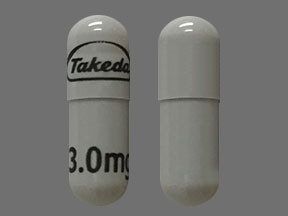Ixazomib Disease Interactions
There are 5 disease interactions with ixazomib.
Ixazomib (applies to ixazomib) gastrointestinal toxicities
Moderate Potential Hazard, Moderate plausibility. Applicable conditions: Diarrhea, Vomiting, Constipation
Ixazomib may cause diarrhea, constipation, nausea, and vomiting. Care should be taken when using this agent in patients experiencing gastrointestinal complications. Dosing should be adjusted for Grade 3 or 4 symptoms. The use of antidiarrheal and antiemetic medications and supportive care may be necessary.
Ixazomib (applies to ixazomib) hepatic impairment
Moderate Potential Hazard, Moderate plausibility. Applicable conditions: Liver Disease
In pharmacokinetic (PK) studies of ixazomib, dose-normalized mean AUC was 20% higher in patients with moderate (total bilirubin greater than 1.5 to 3 times the upper limit of normal [1.5 to 3 x ULN]) or severe (total bilirubin greater than 3 x ULN) liver dysfunction as compared to patients with normal liver function. The PKs of ixazomib were similar in patients with normal liver function and in patients with mild liver dysfunction (total bilirubin up to ULN and AST greater than ULN or total bilirubin greater than 1 to 1.5 x ULN and any AST) based on population PK analysis. The starting dose of ixazomib should be reduced in patients with moderate or severe liver dysfunction; caution should be exercised in these patients. Drug-induced liver injury, hepatocellular injury, hepatic steatosis, cholestatic hepatitis, and hepatotoxicity have been reported with ixazomib; hepatic enzymes should be monitored regularly and dosing should be adjusted for Grade 3 or 4 symptoms.
Ixazomib (applies to ixazomib) peripheral neuropathy
Moderate Potential Hazard, Moderate plausibility.
Peripheral neuropathy has been reported with the use of ixazomib. Patients should be monitored for symptoms of neuropathy, and those experiencing new or worsening peripheral neuropathy may require dose modification.
Ixazomib (applies to ixazomib) renal impairment
Moderate Potential Hazard, Moderate plausibility. Applicable conditions: Renal Dysfunction
In pharmacokinetic (PK) studies of ixazomib, mean AUC was 39% higher in patients with severe renal dysfunction (CrCl less than 30 mL/min) or ESRD requiring dialysis as compared to patients with normal renal function (CrCl at least 90 mL/min). The PKs of ixazomib were similar in patients with normal renal function and in patients with mild or moderate renal dysfunction (CrCl at least 30 mL/min) based on population PK analysis. The starting dose should be reduced in patients with severe renal dysfunction or ESRD requiring dialysis; caution should be exercised in these patients. Ixazomib is not dialyzable and therefore can be administered without regard to the timing of dialysis.
Ixazomib (applies to ixazomib) thrombocytopenia
Moderate Potential Hazard, Moderate plausibility.
Thrombocytopenia has been reported with the use of ixazomib. Before starting a new cycle of therapy, platelet count should be at least 75,000/mm3. Platelet counts should be monitored at least monthly during treatment; more frequent monitoring should be considered during the first 3 cycles. Thrombocytopenia should be managed with dose modifications and platelet transfusions as per standard medical guidelines.
Switch to professional interaction data
Ixazomib drug interactions
There are 362 drug interactions with ixazomib.
Ixazomib alcohol/food interactions
There is 1 alcohol/food interaction with ixazomib.
More about ixazomib
- ixazomib consumer information
- Check interactions
- Compare alternatives
- Reviews (3)
- Side effects
- Dosage information
- During pregnancy
- Drug class: proteasome inhibitors
- Breastfeeding
- En español
Related treatment guides
Drug Interaction Classification
| Highly clinically significant. Avoid combinations; the risk of the interaction outweighs the benefit. | |
| Moderately clinically significant. Usually avoid combinations; use it only under special circumstances. | |
| Minimally clinically significant. Minimize risk; assess risk and consider an alternative drug, take steps to circumvent the interaction risk and/or institute a monitoring plan. | |
| No interaction information available. |
See also:
Further information
Always consult your healthcare provider to ensure the information displayed on this page applies to your personal circumstances.


